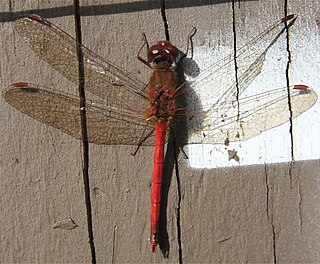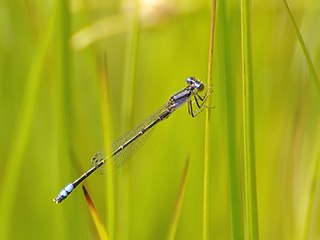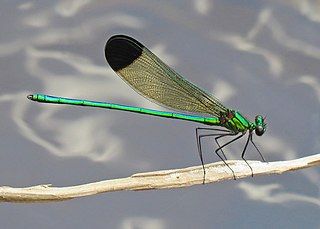
Damselflies are flying insects of the suborder Zygoptera in the order Odonata. They are similar to dragonflies but are smaller and have slimmer bodies. Most species fold the wings along the body when at rest, unlike dragonflies which hold the wings flat and away from the body. An ancient group, damselflies have existed since at least the Lower Permian beginning about 299 million years ago, and are found on every continent except Antarctica.

The green darner or common green darner, after its resemblance to a darning needle, is a species of dragonfly in the family Aeshnidae. One of the most common and abundant species throughout North America, it also ranges south to Panama. It is well known for its great migration distance from the northern United States south into Texas and Mexico. It also occurs in the Caribbean, Tahiti, and Asia from Japan to mainland China. It is the official insect for the state of Washington in the United States.

Ischnura senegalensis, also known variously as common bluetail, marsh bluetail, ubiquitous bluetail, African bluetail, and Senegal golden dartlet, is a widespread damselfly of the family Coenagrionidae. It is native from Africa, through the Middle East, to southern and eastern Asia.

The small red damselfly is a small damselfly flying in heathland bogs and streams. It is in the family Coenagrionidae.

Elattoneura glauca is a species of damselfly in the family Platycnemididae. It is known also as the common threadtail, the grey threadtail or gewone draadstertjie. It is native to the southern half of the African continent, where it is widespread. It lives in shady areas along rivers and streams.

Neoneura is a genus of damselfly in the threadtail family Coenagrionidae. They are found in the Neotropics, from Cuba and Texas to Argentina.

Somatochlora sahlbergi, the treeline emerald, is a species of dragonfly in the family Corduliidae. It is found at high latitudes across northern Eurasia and North America, and occurs farther north than any other dragonfly.

Trithemis annulata, known commonly as the violet dropwing, violet-marked darter, purple-blushed darter or plum-coloured dropwing, is a species of dragonfly in the family Libellulidae. It is found in most of Africa, in the Middle East, in the Arabian Peninsula and southern Europe. These insects are called dropwings because of their habit of immediately lowering their wings after landing on a perch. Males of this species are violet-red with red veins in the wings while females are yellow and brown. Both sexes have red eyes.

The Protoneuridae are a family of damselflies. Most species are commonly known as threadtails, while others are commonly known as bambootails.

Sympetrum vicinum, the yellow-legged meadowhawk or autumn meadowhawk, is a member of the Libellulidae family. It grows to 26–35 mm long.

Eastern forktail is a member of the damselfly family Coenagrionidae.

The orange bluet is a species of damselfly in the family Coenagrionidae.

Chalcolestes viridis, formerly Lestes viridis, is a damselfly of the family Lestidae. It has a metallic green body and at rest it holds its wings away from its body. Its common name is the willow emerald damselfly, the green emerald damselfly, or the western willow spreadwing. It has an elongated abdomen and pale brown spots on its wings and resides in areas of still water with overhanging trees.

Proischnura polychromatica, the mauve bluet, is a small species of damselfly in the family Coenagrionidae. It is endemic to a small area of Cape Province in South Africa. The adult male has a mauve sheen to its dark-coloured body, a bronze-green thorax striped with mauve, and a pale brown abdomen with a bronze-green dorsal stripe. The female is mainly pale brown. The natural habitat of this damselfly is transient pools in stream beds with floating vegetation, especially sedges. Although previously more widespread, it is now known from a single location where it is threatened by the encroachment of cattle and the loss of suitable habitat. For these reasons, the International Union for Conservation of Nature has rated it as "endangered".

Pseudagrion rubriceps, saffron-faced blue dart, is a species of damselfly in the family Coenagrionidae. It is found in many tropical Asian countries.

The blue-fronted dancer is a species of damselfly in the family Coenagrionidae, native to parts of North America. It was first described by the American zoologist Thomas Say in 1840. It is a common species with a wide range and the International Union for Conservation of Nature has assessed its conservation status as being of "least concern".

Ischnura erratica, the swift forktail, is a species of damselfly in the family Coenagrionidae. It is native to the Pacific Northwest, ranging from British Columbia to northern California.

Nososticta solitaria is an Australian species of damselfly in the family Platycnemididae, commonly known as the fivespot threadtail. It is found only in north-eastern Australia.

Calopteryx dimidiata, the sparkling jewelwing, is a species of damselfly in the family Calopterygidae. It is endemic to the eastern and southeastern United States. Its natural habitat is woodland and open areas near forest rivers and streams.

Acanthagrion quadratum, or Mexican wedgetail, is a pond damselfly of the family Coenagrionidae. It was first described by Edmond de Sélys Longchamps in 1876.




















